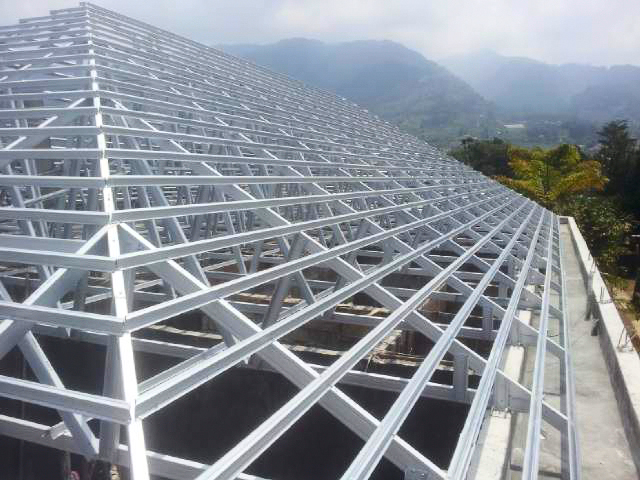 Bahasa Indonesia
Bahasa Indonesia  Inggris
Inggris
 Bahasa Indonesia
Bahasa Indonesia  Inggris
Inggris
 Atap menjadi bagian yang tidak terpisahkan dari bangunan. Seperti yang Anda pahami, atap menjadi elemen fungsional yang melindungi anggota keluarga dari cuaca di luar ruangan. Namun, apakah Anda mengetahui bahwa jenis atap sangat banyak?
Atap menjadi bagian yang tidak terpisahkan dari bangunan. Seperti yang Anda pahami, atap menjadi elemen fungsional yang melindungi anggota keluarga dari cuaca di luar ruangan. Namun, apakah Anda mengetahui bahwa jenis atap sangat banyak?
Dalam dunia arsitektur terdapat banyak jenis atap, mulai dari atap pelana, datar, gambrel, limas atau perisai, sandar atau skilion, dan mansard. Indonesia yang beriklim tropis pun banyak menentukan banyaknya ragam bentuk atap yang tercermin di rumah adat dari setiap daerah.
Arsitek Pandya Praditya menuturkan, pengaplikasian material dan bentuk atap rumah yang disesuaikan dengan iklim tropis Indonesia tidak dapat ditentukan secara pasti ketepatannya. “Semua tergantung pada konsep dari masing-masing arsitek dalam menyiasati iklim,” tuturnya.
Contohnya aplikasi roof garden akan memberi keleluasaan bahwa atap juga dapat difungsikan sebagai taman dengan rumput sebagai peredam panas.
Pada umumnya, konstruksi kerangka atap terdiri dari tiga bagian yakni penutup, gording, dan rangka kuda-kuda. Bagian penutup diletakkan paling luar di atas rangka atap yang terdiri dari kuda-kuda dan gording. Rangka atap tersebut akan disesuaikan dengan bentuk atap yang diinginkan.
Menurutnya, beberapa material rangka yang direkomendasikan adalah kayu, baja ringan, baja murni. Fungsi rangka yang menopang penutup atap harus memiliki daya tahan kuat. Bila Anda menggunakan material kayu, jenis kayu seperti jati, merbau, dan meranti dapat menjadi pilihan. Namun, musuh utama kayu adalah air, api, dan rayap. “Sebisa mungkin jangan menggunakan jenis kayu yang tidak diperuntukkan untuk rangka atap karena akan berumur pendek dan berbahaya bila tidak mampu menopang beban penutup atap,” jelasnya.
Alternatif selanjutnya adalah baja ringan. Material ini tergolong memiliki ketangguhan yang lebih baik bila dibandingkan dengan kayu. Kelebihan lainnnya adalah ketahanannya pada korosi, ringan, dan memiliki ukuran yang presisi. Namun, Anda perlu memahami bahwa kelemahan dari baja ringan adalah diperlukan jumlah yang banyak untuk menopang penutup atap. Akibatnya ruang di bawah atap tidak bisa dimanfaatkan.
Material baja murni juga dapat dijadikan sebagai rangka atap. “Alasannya karena baja murni memiliki struktur yang lebih kokoh dibandingkan dengan kayu dan baja ringan. Namun, ketebalan baja murni memberikan beban yang cukup besar pada pondasi dan kolom.”
MATERIAL ATAP
Setelah menentukan material pembuat rangka, barulah Anda dapat leluasa memilih material atap.
Beberapa jenis material yang umum digunakan adalah genteng, bitumen, zincalume, dan asbes. Setiap material memiliki kelebihan dan kekurangan, tetapi hampir dapat digunakan di seluruh model atap.
Genteng adalah material atap yang paling banyak digunakan. Bahan bakunya pun beragam mulai dari tanah liat, keramik, beton, dan metal. Kelebihan material ini adalah ukurannya yang relatif kecil sehingga bila terjadi kerusakan akan memudahkan proses perbaikan. Kemudian bentuk dan warna yang beragam dapat disesuaikan dengan gaya arsitektur hunian Anda.
Selain genteng, material asbes juga banyak digunakan oleh masyarakat urban. Namun, material ini sudah tidal lagi disarankan karena memiliki kandungan yang berbahaya bagi kesehatan. Lebih dari 50 negara di dunia melarang penggunaan asbes sebagai atap bangunan. Di Indonesia, salah satu jenis asbes yang lazim dipakai adalah chrysotile atau asbes putih. Setelah atap selesai dibangun, Anda harus mulai memikirkan plafon sebagai pembatas atap di bagian dalam ruangan. Tujuannya sebagai penyaring hawa panas yang terserap atap sehingga tidak langsung masuk ke dalam ruangan. Ruang di antara plafon dan atap disebut sebagai ruang bawah atap atau attic.
Beberapa pemilik rumah seringkali membiarkannya kosong, tetapi ada pula yang memanfaatkannya sebagai gudang bahkan kamar tidur.
Menurut Pandya, tinggi ruang bawah atap tergantung pada desainer atau arsitek yang merancangnya. Guna menghilangkan hawa panas yang terjebak dalam loteng, maka dapat dibuat lubang udara pada atas sehingga sirkulasi udara lebih lancar. “Untuk bentuk atap miring relatif lebih mudah membuat lubang udara tersebut. Namun, untuk bentuk atap datar agak sulit karena rawan terjadi kebocoran saat turun hujan. Anda tinggal menyesuaikannya saja,” jelasnya.

Beberapa Fungsi Atap Baja Ringan untuk Rangka Suatu Bangunan
Solusi Perbaiki Atap Rumah Bersama dengan Jasa Renovasi Rumah Murah



